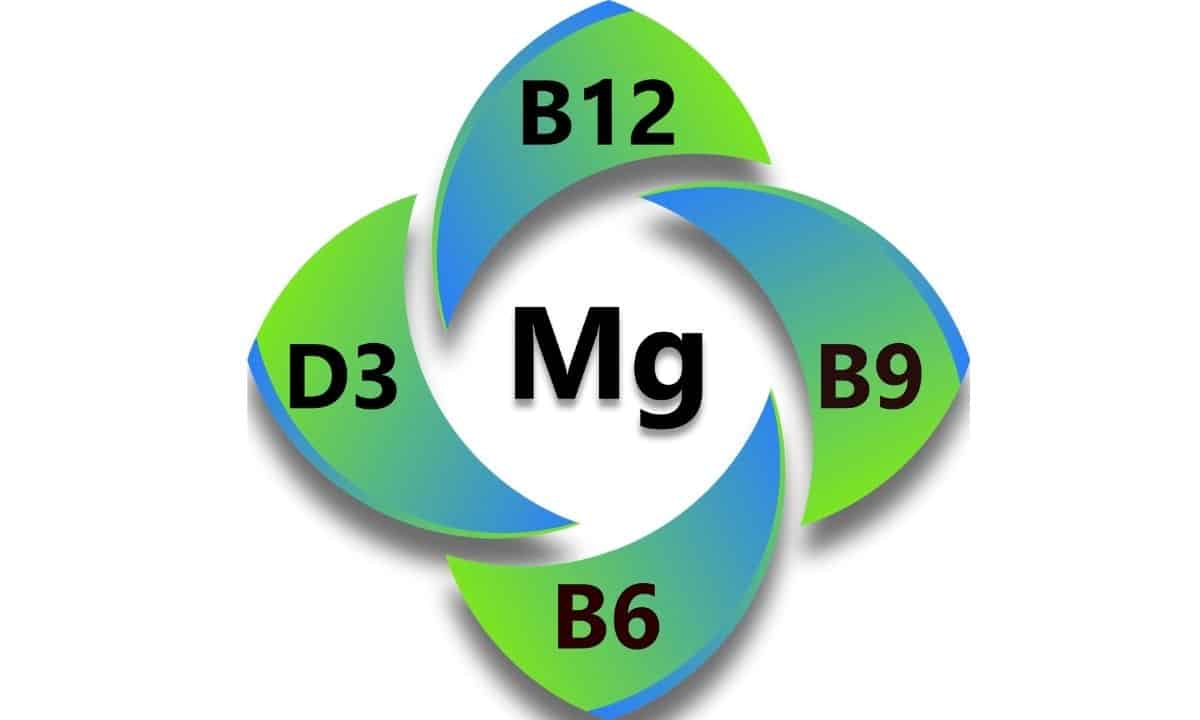
The fusion of essential nutrients
MAG-FUSION is the perfect fusion of essential nutrients that play an important role as cofactors for the synthesis of various neurotransmitters necessary for general neurological health, for protein metabolism, DNA and RNA formation, and for calcium fixation in the bones. It consists of the combination of magnesium chelate (trimagnesium dicitrate), a selection of 3 B complex vitamins (vitamins B6, B12 and B9-folate) and premium quality vitamin D3.
MAG-FUSION is the perfect fusion of essential nutrients that play an important role as cofactors for the synthesis of various neurotransmitters necessary for general neurological health, for energy metabolism, for the formation of DNA/RNA and for the fixation of calcium in the bones. This food supplement combines magnesium citrate, a selection of 3 vitamins from the B complex (vitamins B6, B12 and B9-folate) and vitamin D3.
🔹 The combination of magnesium and vitamins B12, B6 and B9 contributes to energy metabolism, reducing tiredness and fatigue. This combination also plays an important role in the metabolism of amino acids, in the decrease of homocysteine levels and participates in the functioning of the nervous system, contributing to the development of a normal psychological function.
🔹 The presence of magnesium in the form of magnesium citrate 3: 2 (trimagnesium dicitrate) guarantees greater bioabsorption of this mineral.
🔹 The combination of magnesium and vitamin D3 is essential for the absorption of calcium and phosphate, which is essential for healthy bones and normal muscle function.
🔹Magnesium is an essential cofactor for the activation of vitamin D3, and activated vitamin D3, in turn, further increases intestinal absorption of magnesium.
MAG-FUSION's unbeatable formula:
Magnesium in the chelated form of trimagnesium dicitrate, also known as 3: 2 magnesium citrate, has greater bioabsorption (better absorption by the body) than the more commonly used chemical forms of “inorganic salts”, such as case of magnesium bicarbonate, chloride, oxide, phosphate or sulfate [1, 2]. Furthermore, compared to common magnesium citrate, magnesium dicitrate provides more elementary magnesium per unit of citrate molecule and presents the best cost / benefit among the chelated forms.
The importance of Magnesium:
Magnesium is part of the mineral structure of bone, which is why it is used to prevent and treat osteoporosis [3]. In fact, magnesium is an essential macroelement for the assimilation of calcium and vitamin D [4, 5]. Magnesium is also used in various muscle dysfunctions (exhaustion, cramps, spasms, tics or tremors), as it regulates the contraction and relaxation of muscles. [6]. Due to its role in numerous metabolic processes such as the activation of key enzymes in glycolysis, it is used to improve the response and action of insulin in diabetics [7]. On the other hand, magnesium is effective in preventing or destroying calcium oxalate kidney stones, by reducing the urinary saturation of this salt [8].
Studies have shown that magnesium also decreases anxiety and helps relieve headaches and migraines. Magnesium favors the normalization of certain brain functions. This has a relaxing effect on the vein walls and therefore magnesium helps to relieve pressure on veins and arteries in the head that causes headaches and the pain of the dreaded migraines. These relaxing properties also promote blood circulation and the cardiovascular system [9]. Since it relaxes the muscles, it can be used in the treatment of chronic stress and improve resistance to fatigue [10].
Vitamin B6 is a group of three compounds called pyridoxine, pyridoxal, and pyridoxamine. Pyridoxal-5′-phosphate, also known as P5P is the bioactive form of vitamin B6 that can be used directly by the body without conversion.
Each of these forms of vitamin B6 performs unique functions in our body, but only the pyridoxal-5′-phosphate form has an active coenzyme function, participating in approximately 168 vital enzymatic processes in our body [11, 12].
P5P controls the metabolism of proteins and amino acids and, to a lesser extent, that of lipids and carbohydrates [13]. It also participates in the formation of hemoglobin, antibodies and in the synthesis of DNA and RNA, and is related to cognitive function, as it helps in the production of neurotransmitters [11]. In addition, P5P helps transport magnesium across cell membranes, helping to increase its absorption rate [14].
Vitamin B9 or folates is the generic term for a family of chemically similar compounds that have been recognized as beneficial for the prevention of a variety of conditions. Of all the available forms of folates, the one that really interests us is the chemical form (6S) -5-methyltetrahydrofolate (5-MTHF). This is the bioactive form of vitamin B9. The other forms need to be digested in the intestine by the enzyme dihydrofolate reductase (DHFR) for their conversion into 5-MTHF [15].In MAG-FUSION, vitamin B9 is presented directly in the form of (6S) -5-methyltetrahydrofolate (5-MTHF). Furthermore, as Premium level quality is a characteristic of Nutribiolite, in MAG-FUSION 5-MTHF is provided in the form of 5-MTHF glucosamine salt, also referred to as 4th generation folate or Quatrefolic®. According to laboratory studies, this patented form has an absorption 1.8 times higher than that of calcium (6S) -5-methyltetrahydrofolate, the chemical form of 5-MTHF used in other food supplements [16].
Folic acid is a commercially produced synthetic molecule whose chemical nomenclature is pteroylmonoglutamic acid. This form does not exist in nature and is used in lower quality food supplements or to enrich various food products such as breakfast cereals or bread. Unlike other types of folates, folic acid is not reconverted by our digestive system by dihydrofolate reductase (DHFR), but rather needs to be metabolized at the liver level [17]. Due to the advantage of the 5-MTHF glucosamine salt (4th generation folate) regarding its bioavailability, it has been verified in in vivo studies that its absorption is 3.1 times higher than that of folic acid [16].
The importance of vitamin B9 (5-MTHF):
5-MTHF participates in the synthesis of puric and pyrimidic bases, precursors of nucleic acids, so it is essential for the formation of DNA and its deficiency especially affects blood cells and those that are in the rapid division phase [18]. 5-MTHF is necessary for the formation of the fetal nervous system (days 15-28 after conception). In addition, it seems to be involved in the metabolic pathway of the enzyme methionine synthetase together with vitamin B12 (another vitamin present in the MAG-FUSION formula), so supplementation with this vitamin reduces homocysteine levels. [19].Homocysteine, a sulfurized amino acid that originates from the metabolism of methionine, is a very aggressive molecule for the arterial endothelium. Numerous studies suggest that excess plasma homocysteine is associated with an increased risk of coronary, cerebral vascular and peripheral disease, independently of other conventional risk factors, although homocysteine interacts with other risk factors, such as smoking, hypertension and diabetes [20].
There are two forms of vitamin B12 that you are likely to find in food supplements: methylcobalamin and cyanocobalamin. Cyanocobalamin is a synthetic form of vitamin B12, widely used in food supplements because it is cheaper and has better stability in air. [21]. However, this form has a lower bioavailability, since the body first needs to get rid of the cyanide group (decyanation) after the action of the enzyme cyanocobalamin reductase. After the action of this enzyme, cyanocobalamin, it is finally converted into methylcobalamin or adenosylcobalamin, which are the two active forms of vitamin B12 [22]. Unlike cyanocobalamin, methylcobalamin is a natural form of vitamin B12 that can also be obtained from food sources such as fish, meat, eggs, and milk.
The importance of vitamin B12:
Vitamin B12 works together with vitamin B9 in the active division of hematopoietic cells [23] . Hematopoietic cells are the stem cells that give rise to other blood cells. It is a fundamental vitamin, together with vitamin B9 (also present in the MAG-FUSION formula) in the production of erythrocytes (red blood cells) and in the synthesis of deoxyribonucleic (DNA) and ribonucleic (RNA) acids. The contribution of vitamin B12 achieves proper neural function and prevents fertility problems and difficulties during pregnancy [24].
MAG-FUSION has cholecalciferol or vitamin D3 as a form of vitamin D. This is the most effective form of vitamin D due to its more efficient conversion to calcifediol in the body. The other form of vitamin D is vitamin D2 or ergocalciferol. The potency of vitamin D2 is less than a third of that of vitamin D3 and its action in the body is shorter [25].
The main function of vitamin D3 is to promote the mineralization of bones. To do this, it increases the intestinal absorption of calcium and phosphate and the reabsorption of calcium at the renal level and inhibits the action of parathyroid hormone, also known as parathyroid hormone (PTH). [26].
This hormone is secreted and stored by the parathyroid gland and is one of the most important regulators of mineral metabolism. It has a decisive role in maintaining adequate concentrations of calcium and phosphorus in the blood, as well as in the development and maintenance of bone health.
An important factor in the activation of vitamin D is magnesium (present in the MAG-FUSION formula). As mentioned above, magnesium helps activate vitamin D as all the enzymes that metabolize vitamin D appear to require magnesium, which acts as a cofactor in enzymatic reactions in the liver and kidneys. Deficiency in vitamin D and magnesium is associated with various disorders, such as skeletal deformities, cardiovascular diseases, and metabolic syndrome. Therefore, it is essential to ensure that the recommended amount of magnesium is consumed to obtain the optimal benefits of vitamin D [5].
Clinical studies also suggest that vitamin D deficiency may lead to an increased risk of central nervous system (CNS) disease, particularly schizophrenia and multiple sclerosis. Adequate intake of vitamin D during pregnancy and the neonatal period appears to be crucial for the prevention of these diseases [27].
- Walker, A.F., et al., Mg citrate found more bioavailable than other Mg preparations in a randomised, double-blind study. Magnes Res, 2003. 16(3): p. 183-91.
- Coudray, C., et al., Study of magnesium bioavailability from ten organic and inorganic Mg salts in Mg-depleted rats using a stable isotope approach. Magnesium Research, 2005. 18(4): p. 215-223.
- Castiglioni, S., et al., Magnesium and osteoporosis: current state of knowledge and future research directions. Nutrients, 2013. 5(8): p. 3022-3033.
- Abraham, G.E. and H. Grewal, A total dietary program emphasizing magnesium instead of calcium. Effect on the mineral density of calcaneous bone in postmenopausal women on hormonal therapy. J Reprod Med, 1990. 35(5): p. 503-7.
- Uwitonze, A.M. and M.S. Razzaque, Role of Magnesium in Vitamin D Activation and Function. The Journal of the American Osteopathic Association, 2018. 118(3): p. 181-189.
- Barbagallo, M. and L.M. Resnick, Calcium and Magnesium in the Regulation of Smooth Muscle Function and Blood Pressure, in Endocrinology of the Vasculature, J.R. Sowers, Editor. 1996, Humana Press: Totowa, NJ. p. 283-300.
- Barbagallo, M. and L.J. Dominguez, Magnesium and type 2 diabetes. World journal of diabetes, 2015. 6(10): p. 1152-1157.
- Liebman, M. and G. Costa, Effects of calcium and magnesium on urinary oxalate excretion after oxalate loads. J Urol, 2000. 163(5): p. 1565-9.
- Cuciureanu, M.D. and R. Vink, Magnesium and stress, in Magnesium in the Central Nervous System, R. Vink and M. Nechifor, Editors. 2011, University of Adelaide Press. p. 251-268.
- D’Angelo, E.K., H.A. Singer, and C.M. Rembold, Magnesium relaxes arterial smooth muscle by decreasing intracellular Ca2+ without changing intracellular Mg2+. The Journal of clinical investigation, 1992. 89(6): p. 1988-1994.
- Spinneker, A., et al., Vitamin B6 status, deficiency and its consequences: an overview. Nutrición Hospitalaria, 2007. 22: p. 7-24.
- EXPASY: Swiss Bioinformatics Resource Portal -Search in ENZYME for: Cofactor Pyridoxal 5′-phosphate. Available from: https://enzyme.expasy.org/cgi-bin/enzyme/enzyme-search-cf?Pyridoxal_5%27-phosphate.
- Divins Triviño, M.-J., Vitaminas. Farmacia Profesional, 2004. 18(4): p. 24-32.
- Pouteau, E., et al., Superiority of magnesium and vitamin B6 over magnesium alone on severe stress in healthy adults with low magnesemia: A randomized, single-blind clinical trial. PLOS ONE, 2018. 13(12): p. e0208454.
- Visentin, M., et al., The intestinal absorption of folates. Annual review of physiology, 2014. 76: p. 251-274.
- Miraglia, N., et al., Enhanced oral bioavailability of a novel folate salt: comparison with folic acid and a calcium folate salt in a pharmacokinetic study in rats. Minerva Ginecol, 2016. 68(2): p. 99-105.
- Patanwala, I., et al., Folic acid handling by the human gut: implications for food fortification and supplementation. The American Journal of Clinical Nutrition, 2014. 100(2): p. 593-599.
- Crider, K.S., et al., Folate and DNA methylation: a review of molecular mechanisms and the evidence for folate’s role. Advances in nutrition (Bethesda, Md.), 2012. 3(1): p. 21-38.
- Clément, A., et al., 5-Methyltetrahydrofolate reduces blood homocysteine level significantly in C677T methyltetrahydrofolate reductase single-nucleotide polymorphism carriers consulting for infertility. Journal of Gynecology Obstetrics and Human Reproduction, 2020. 49(1): p. 101622.
- Pintó Sala, X., La homocisteína como factor de riesgo cardiovascular. Medicina Integral, 2000. 36(5): p. 179-185.
- Bartilucci, A. and N.E. Foss, Cyanocobalamin (Vitamin B12): I. A Study of the Stability of Cyanocobalamin and Ascorbic Acid in Liquid Formulations. Journal of the American Pharmaceutical Association (Scientific ed.), 1954. 43(3): p. 159-162.
- Paul, C. and D.M. Brady, Comparative Bioavailability and Utilization of Particular Forms of B(12) Supplements With Potential to Mitigate B(12)-related Genetic Polymorphisms. Integrative medicine (Encinitas, Calif.), 2017. 16(1): p. 42-49.
- Herbert, V. and K.C. Das, The Role of Vitamin B12 and Folic Acid in Hemato- and Other Cell-Poiesis, in Vitamins & Hormones, P.L. Munson, et al., Editors. 1976, Academic Press. p. 1-30.
- Molloy, A.M., et al., Maternal vitamin B12 status and risk of neural tube defects in a population with high neural tube defect prevalence and no folic Acid fortification. Pediatrics, 2009. 123(3): p. 917-923.
- Armas, L.A., B.W. Hollis, and R.P. Heaney, Vitamin D2 is much less effective than vitamin D3 in humans. J Clin Endocrinol Metab, 2004. 89(11): p. 5387-91.
- Christakos, S., et al., Vitamin D endocrine system and the intestine. BoneKEy reports, 2014. 3: p. 496-496.
- Wrzosek, M., et al., Vitamin D and the central nervous system. Pharmacol Rep, 2013. 65(2): p. 271-8.
Subscribe to our newsletter to save 5% on your first order.
This offer can be combined with all the other offers in the website.
Thank you!
You have successfully joined us. Please check your email with the discount code.

















